Yen Bai province is located on the border of Lao Cai in the north, Son La in the south, Tuyen Quang in the northeast, and Phu Tho in the southeast. The province is located in Vietnam’s northern midland and mountainous region, covering an area of 6,899.5 square kilometers and housing 750,200 people. Yen Bai province is home to a number of ethnic minorities, including the Hmong, Dao, Tay, Thai, Nung, San Chay, Phu La, and Kinh.
General Information
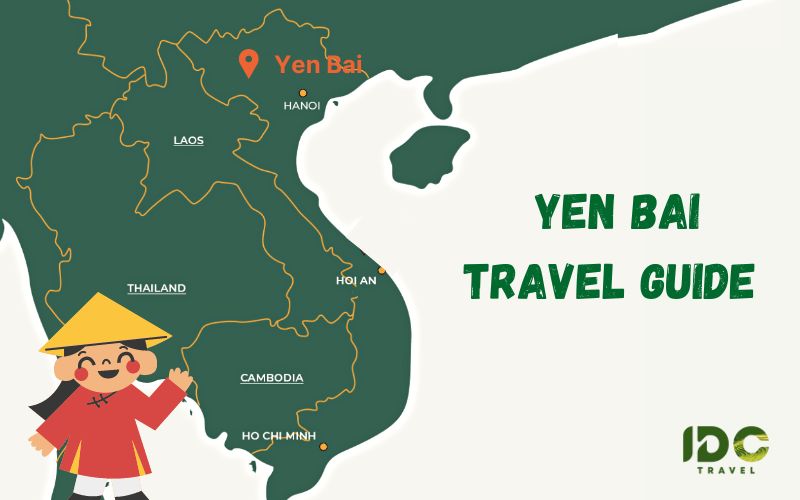
Yen Bai location – travel guide
Yen Bai has a steep topography that rises from Southeast to Northwest, and it is dominated by three majestic colossal mountain ranges in the Northwest-Southeast direction, including Hoang Lien Son Mountain Range – Pu Luong, which lies between the Red River and the Da River, con Voi Mountain (Elephant Mountain), which lies between the Red River and the Chay River, and limestone mountain and limestone mountain between the Chay River and the Lo River. There are two main regions: highland and lowland. Highland is 600m or higher in elevation and covers 67.66% of the province. This area is sparsely populated, with abundant land, forest products, and minerals, as well as a high capacity for mobilizing into socioeconomic development. Lowland with elevations below 600m and primarily low mountainous terrain and basin valley account for 32.44% of the province’s natural area.
Ethnic Minorities in Yen Bai
Because Yen Bai is a mountainous province, it is home to 30 ethnic groups, each of which has its own unique customs and cultural identity that combines with the natural terrain of each region to create a vibrant, lively, and distinctive cultural picture of Yen Bai. This breathtakingly large image is divided into three sections. The first is in Yen Bai province’s west. Visitors will be drawn to the enormous exclusive terraces, the mountain markets where locals trade many local handicraft products to meet the demands of visitors’ enjoyment and souvenir shopping, and the charming traditional Thai folk songs and dances.
The second section is known as the Chay River cultural area, and it is associated with the national landmark Thac Ba Lake (Yen Binh district, Luc Yen district). This region is well-known not only for its breathtaking scenery, but also for the fantastic cultural features of the Cao Lan, White Dao, and Tay ethnic minorities, as well as festivals, architecture, and traditional handicrafts. The final area is the Red River Cultural Area, which is the center of religious festivals such as Dong Cuong Temple, Nam Cuong Temple, Tuan Quan Temple, Nhu Son Temple, Am Pagoda, and others that are annually maintained to be spiritual destinations in Northern Vietnam trips.
Yen Bai Weather and Best Time to Visit
Yen Bai has a tropical monsoon climate with average temperatures ranging from 22oC to 23oC. The climate is divided into two seasons: the cold season (November to March) and the hot season (April to October). This province receives less solar radiation than its neighbors. Winter months are from November to March when the weather is dry. The dry season is ideal for adventure tours such as mountain biking, trekking, and motorcycling. Be sure to prepare lots of warm clothes because the temperature will be very cold, especially in the evenings.
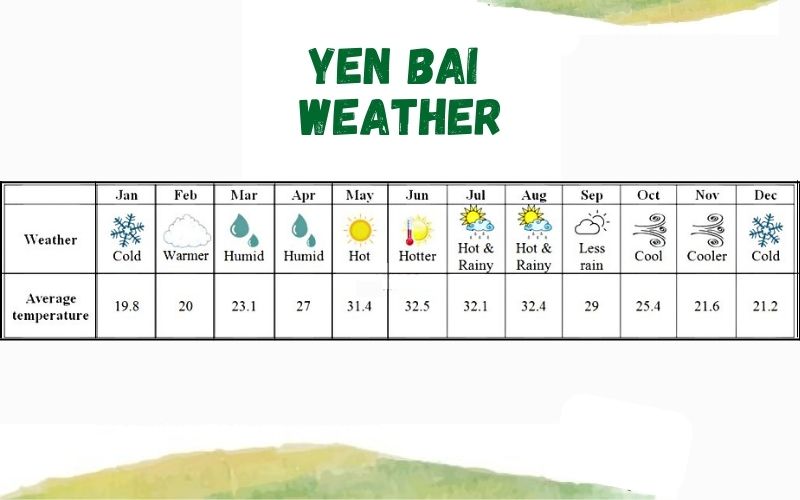
Yen Bai Weather and Best Time to Visit
April to October are the summer months and the rainy period. The average temperature in the district is stable, ranging from 18°C (64°F) to 28°C (82°F).
Those visiting Yen Bai for photography should not miss the two best seasons: May – June (pouring water season) and September – October (ripen rice terrace season), when you can marvel at the wonders of the province’s terraced paddy fields.
Getting to Yen Bai
The distance between Hanoi and Yen Bai City is 156 kilometers. National Highway 32 and National Highway 70 are two main roads linking Hanoi and Yen Bai. The province is also connected by train from Hanoi to Laocai. Tourists can reach Yen Bai by public bus, motorbike, train, or private car with a driver from Hanoi.
By bus
Tourists have many options for bus transfers between Hanoi and popular tourist destinations in Yen Bai based on different travel routes. Daily buses to Yen Bai depart from My Dinh, Yen Nghia, and Giap Bat Bus Stations.
By train
The train between Hanoi and Sapa will stop in Yen Bai. As a result, passengers who suffer from car sickness can take this mode of transportation from Hanoi to Yen Bai City. Trains from Hanoi usually leave at night and arrive at Yen Bai train station in the early morning. It’s worth noting that Hanoi Railway Station has two gates: the main gate at No. 120 Le Duan Street for trains heading south, and the gate at Tran Quy Cap Street for trains heading north to places like Yen Bai and Sapa. Yen Bai Railway Station is located at 218 Tran Hung Dao St. in Yen Bai City.
By motorbike
Most visitors come to Yen Bai to see the golden rice terraces in and around Mu Cang Chai. As a result, they decided to travel by motorcycle from Hanoi to Mu Cang Chai, stopping for one night in Nghia Lo Town. Traveling to Mu Cang Chai by motorbike allows visitors to stop along the way to visit several places that are too far away to walk and have too narrow paths for cars. However, the distance between Hanoi and Mu Cang Chai is approximately 315 kilometers and is mostly in mountainous terrain. As a result, riders must be in good physical condition and confident in their motorcycle riding abilities.
By private car/van
Mu Cang Chai and other areas in Yen Bai are considered ideal for those seeking an alternative to the more well-known regions of Vietnam’s North. However, there isn’t a lot of English information on the Internet about transportation, lodging, and places to visit in Yen Bai. As a result, international tourists may have difficulty making plans to visit this little-known gem. Private car with a driver and tour guide from IDC Travel will be your perfect companions as you explore hidden treasures in this peaceful destination of mountains, ethnic villages, and culture.
What to See in Yen Bai
Thac Ba Lake
This is one of Vietnam’s three largest artificial lakes, covering an area of 23.400 ha, of which 19.05 ha is water and the remaining 4.35ha is islets on the Reservoir. There are 1,133 islands and hills with diverse ecosystems.
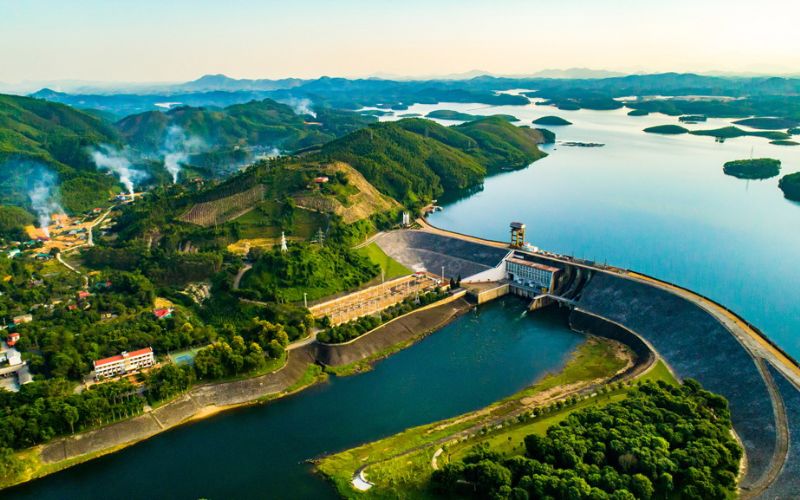
Thac Ba Lake
The lake has become Yen Bai eco tourism‘s pride due to its impressively blue and clear water and a beautiful cave system formed by limestone mountain ranges. Thac Ba is well-known not only for its impressive natural statues and excellent creator works, but also for its historical significance. Tran Nhat Duat led the war against Mongolian invaders in 1285, winning the Thu Vat Battle. The Thuy Tien case was also the revolutionary foundation of the Yen Bai provincial committee during the resistance war against Americans.
- Tourists can enjoy sightseeing at Thuy Tien Cave, Xuan Long Cave, Trinh Nam Island, and other locations.
- Mountain climbing (in the early morning, tourists will have a bird’s eye view of foggy Thac Ba Lake from the peak of Cao Bien, the largest and longest mountain range).
- Hiking
- Interact with Tay, Cao Lan, Nung, H’Mong, Dao, and Phu La ethnic groups.
- Take a listen to the folk songs.
- Local fish dishes such as bream, snake-head, and others, as well as Dai Minh’s famous sweet mandarins and pomelos, are available.
Mu Cang Chai Terraced Fields
Mu Cang Chai, located 300 kilometers from Hanoi, is a well-known district of Yen Bai that attracts thousands of visitors each year due to its magnificent scenery and breathtaking beauty. This town, located in northeastern Vietnam and about 100 meters above sea level, is made up of 700 hectares of terraced rice fields, 70% of which are in three communes: La Pan Tan, Che Cu Nha, and De Su Phinh, all of which have been designated as national landscapes.
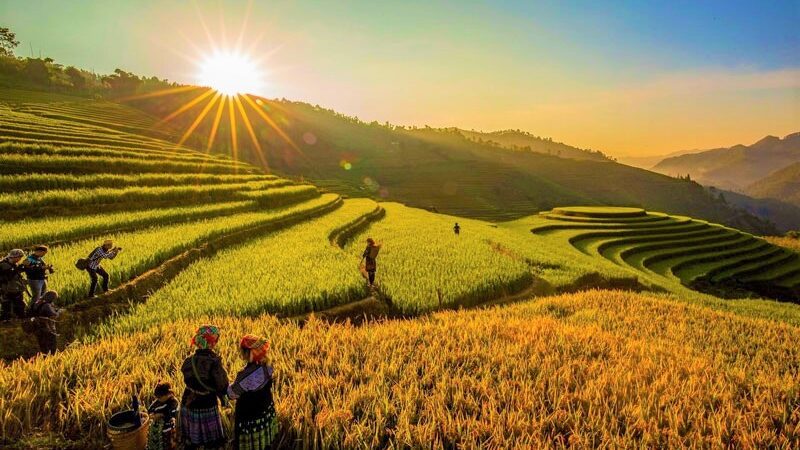
Rice terraces in Mu Cang Chai in October
The breathtakingly beautiful terraced paddy field is a work of art created by human hands that once again demonstrates the value of great labor and human creativity. A visit to the Mu Cang Chai terraces is an unforgettable experience for travelers on a Vietnam tour. The terraced fields are lush with ripening rice in September and October, making it the best time to visit Mu Cang Chai.
Muong Lo Town
Nghia Lo (Muong Lo) is located in a mountainous region with a large number of ladder fields, making it the second largest field in the Northwest and the ancestral home of Thai ethnic people.
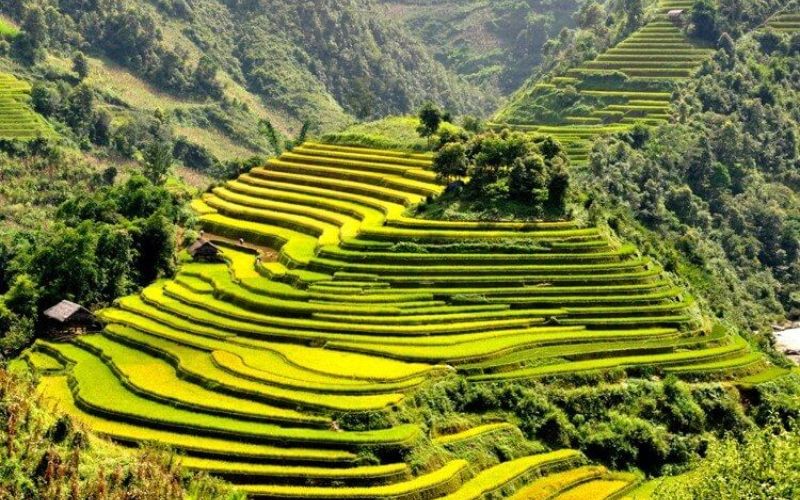
Muong Lo field in the Northwest
The valley is home to 17 ethnic groups, with the Thai constituting the majority. The town is a popular stop for authentic cultural explorers interested in learning about the culture and daily life in Vietnam’s northwestern mountainous region.
Some of the highlights of the Muong Lo itinerary include:
- Visiting idyllic Thai villages and participating in Thai daily life (bicycle tour or on foot)
- Visiting suspension bridges, the Ngoi Thia River, and historical sites, among other things.
- Bathing in a hot spring
- residing in stilt houses
- Cooking Thai food and watching traditional local performances
Dong Cuong Temple
Dong Cuong Temple, also known as Mau Thuong Ngan, is located approximately 50 kilometers from the city of Yen Bai and is one of the two largest temples in the upper reaches of the Red River in Yen Bai.
The temple is dedicated to Ve Quoc as well as the national heroes who fought against the Nguyen Mong (Mongolian) aggressor in the 13th century.
Every year on the 27th and 28th of February, a festival is held here, attracting thousands of tourists from near and far who hope for a lucky year. Traditional games include singing, shuttlecock, wrestling, dancing, and so on.
Pu Nhu Waterfall
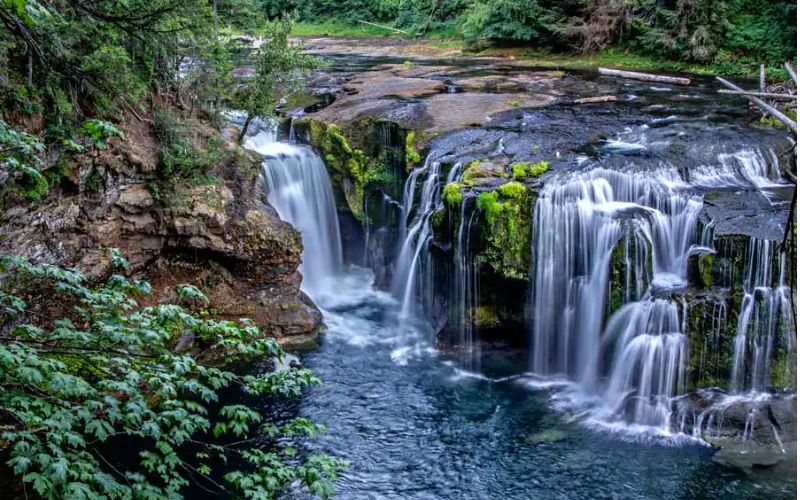
Pu Nhu Waterfall
The Pu Nhu Waterfall is in La Pan Tan Commune, about 10 kilometers west of Mu Cang Chai District. Tourists are strongly advised to stop at Pu Nhu Waterfall on their way to explore the leveling rice terrace fields of La Pan Tan. The water source here comes from the watersheds of Lao Cai and Son La. The 20m waterfall is divided into many steps and is located between two high cliffs of vertical mountains. It cannot be seen from the main highway because it is approximately 1.5 kilometers away. The trail to Pu Nhu Waterfall is very simple to follow: simply pass through a small stream and a cornfield to enjoy the cool atmosphere of the waterfall. The highest temperature in this area is around 26°C, making it an ideal ecotourism destination for day-trippers.
Suoi Giang
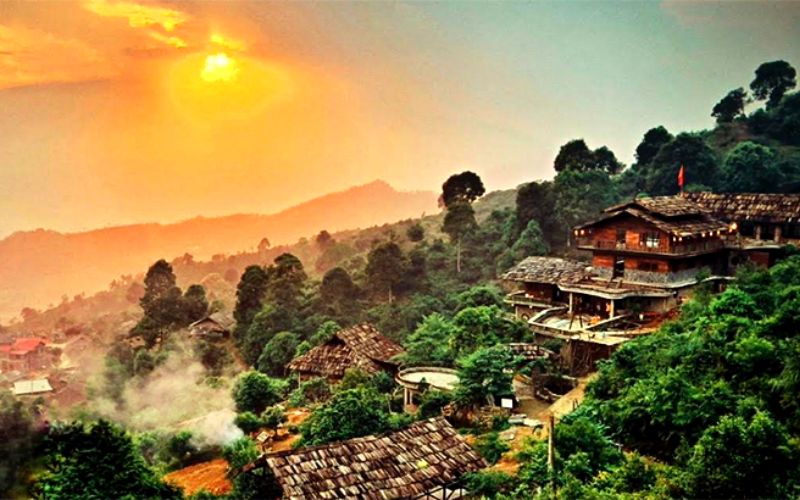
Suoi Giang
This place in Van Chan District is approximately 20 kilometers from Nghia Lo Town and 80 kilometers from Yen Bai City. Suoi Giang is famous for growing over hundred-year-old tea trees, which provide the famous Shan Tuyet tea. It is located at a height of 1,400m above sea level and has a cool climate all year. Locals refer to it as “medical tea” because they believe it can help people improve their health. The area’s small villages and wooden houses of Thai and Hmong ethnic groups create peaceful landscapes that are ideal for authentic cultural exploration.
What to Eat in Yen Bai
Northern Vietnam has the most unique and distinct cuisine in Vietnam, thanks to its incredible ingredients and complicated cooking process. The following are some delectable dishes that should be on any Vietnam discovery tour.
Luc Yen banana cake
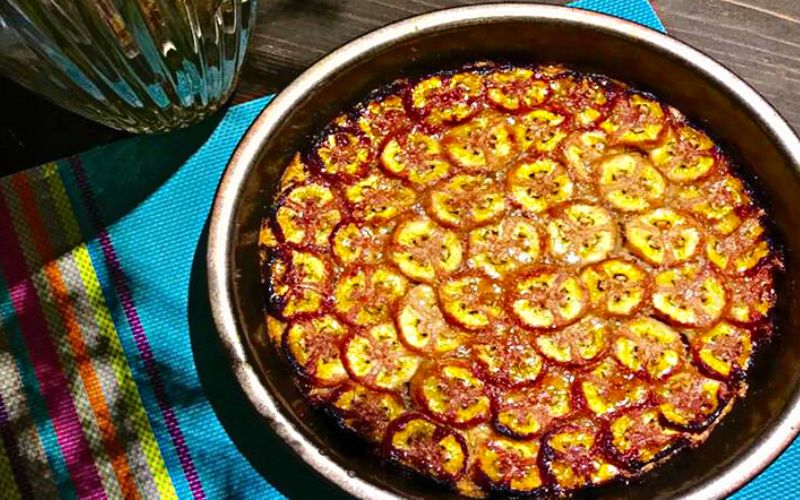
Luc Yen banana cake
This cake is made with ripe bananas that have been soaked in hot water, ground, and mixed with rice powder to coat before being stuffed with sugar, pounded steamed beans, and peanuts. The cake is then wrapped in banana leaves and steamed for 25-30 minutes, giving it a distinct sweet flavor.
Muom muom rang
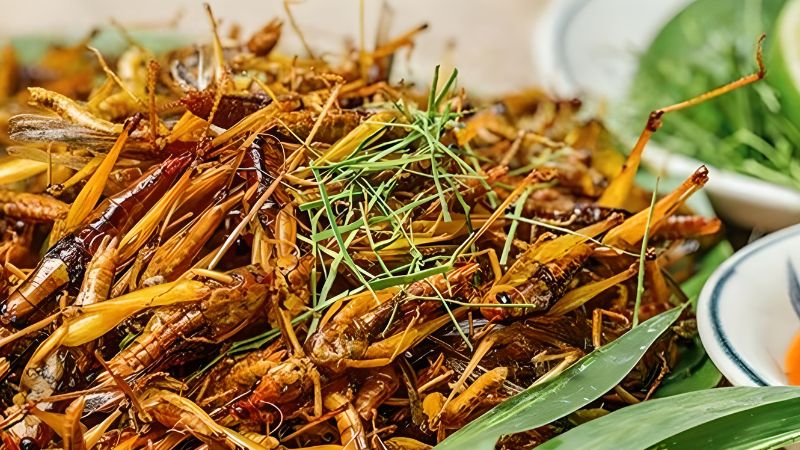
Muom muom rang
The “Muom muom” is a type of bug. When tourists first hear about this food, they may be surprised, but fungus is a key ingredient in Thai cuisine. The fresh fungus is wrapped in banana leaves and grilled until the fat and green liquid comes out.
Sinh fish
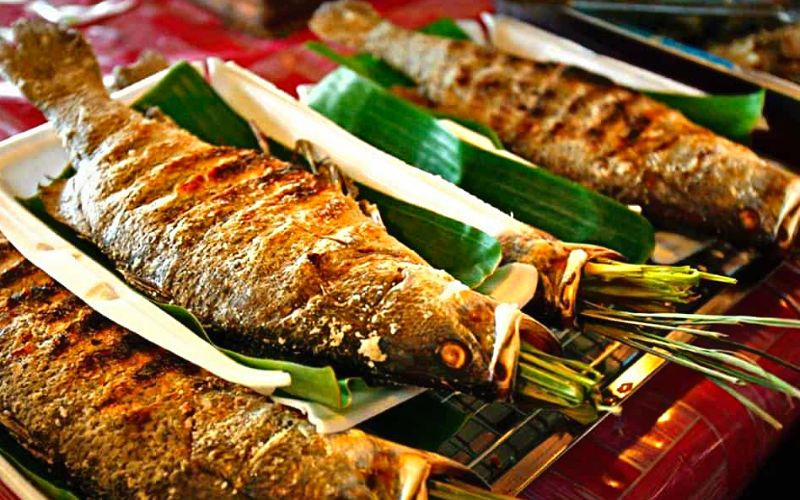
Grilled Sinh fish
Van Chan town is the only place where this type of fish habitat exists. Despite its small size (about four human fingers wide), the meat is tender, and the bonders are extremely soft.
Yen Bai sausage
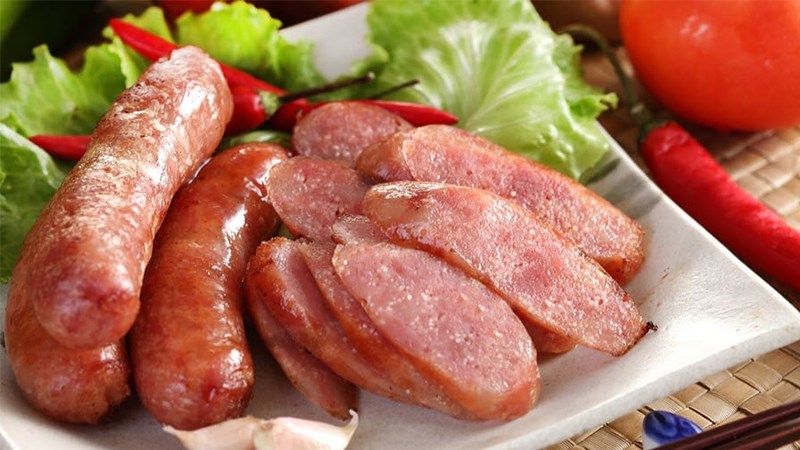
Smoked sausages
This dish is made with chopped bacon, pepper, honey, sugar, and other ingredients. Charcoal, biogas, chaff, and bay leaf are used to dry the sausage. Locals have their own secret technique for seasoning this food, so you won’t find it anywhere else. When eating, the cane has a pleasant smoky scent.
We hope the preceding article was helpful in providing you with information about Yen Bai. Please do not hesitate to contact us and begin planning your Yen Bai tours right now!